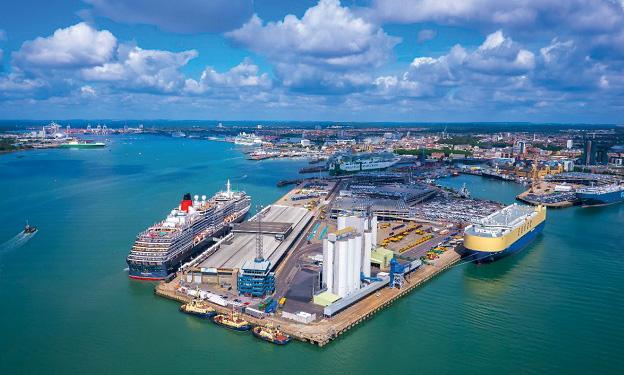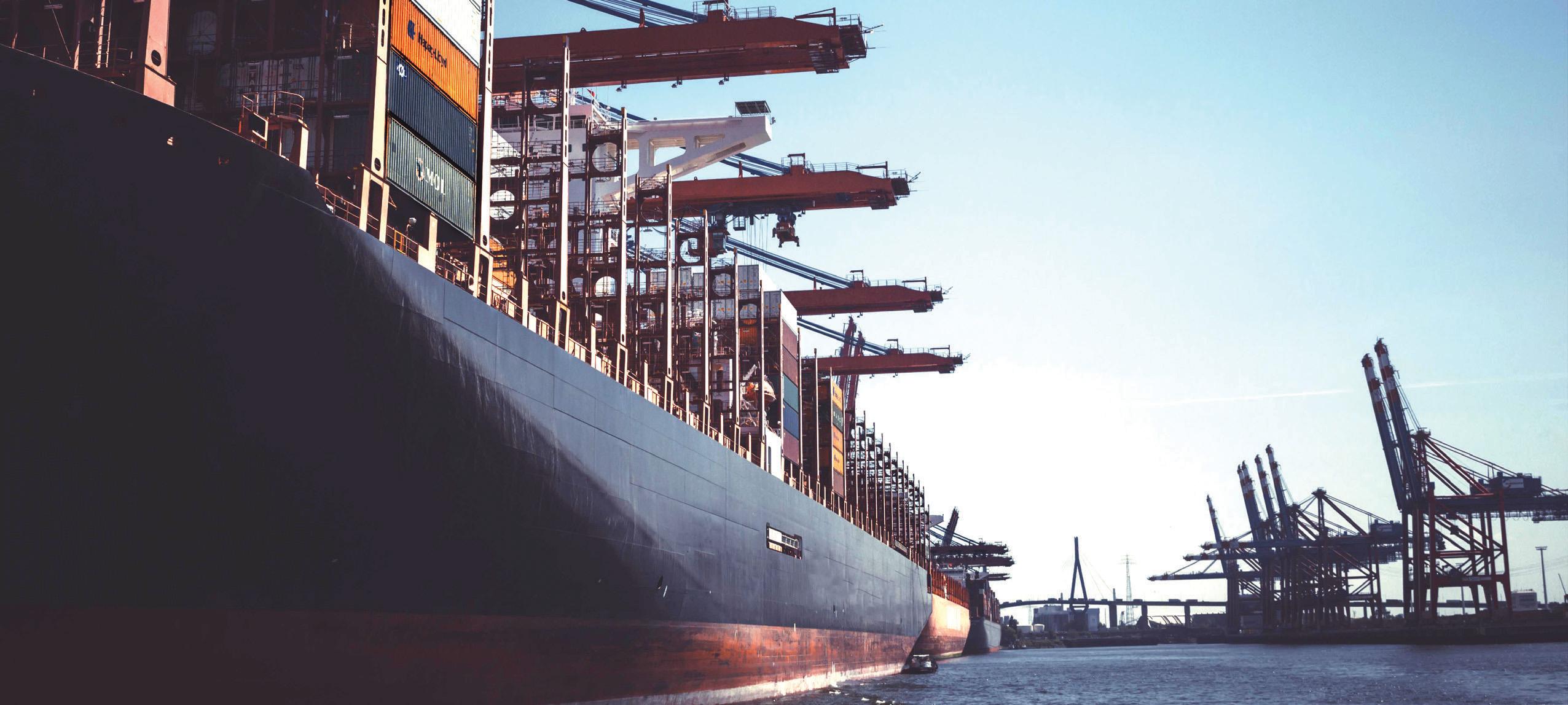
8 minute read
Price of sustainability
WHAT PRICE SUSTAINABILITY?
How green is your money – or someone else’s? Felicity Landon analyses the push for sustainability in loans, fi nance and investments
Finance always came with strings attached. Today, the strings are increasingly ‘green’ or, more broadly, sustainable. As concern for the environment reaches into every area of business and industry, so the expectations around sustainability are taking centre stage.
The past few months have seen a series of announcements around sustainable loans, finance and investments in the ports and shipping world, from the news that Australia’s Port of Newcastle has secured A$515m in sustainability-linked loans to COSCO Shipping Ports announcing the launch of its green finance framework.
As Malin Högberg, Director Corporate Legal at the Swedish Club, says in the P&I club’s annual report, many shipping companies are voluntarily committed to their environmental, social and corporate governance (ESG) approach, but the industry is also seeing pressure from financial institutions and other business partners with initiatives such as the Poseidon Principles and the Sea Cargo Charter.
“People want to invest in an organisation that is sustainable and committed and takes responsibility,” she says. “As a Club, we have to be more transparent about the ESG risks we see and how we work to limit that impact. We have to respond to more stringent laws for financial reporting. At the same time, shipowners are asking what their suppliers are doing in the area, and that – of course – includes us. We have many board members who are passionate on this topic, so there is a lot of engagement.”
In May, the Geneva-based World Association of PPP Units & Professionals (WAPPP) announced that it had established a Port Chapter to address the challenges of public-private partnerships in the port sector. Among its aims – to support the development of new port projects in accordance with the United Nations Sustainable Development Goals.
PPP ESG CRITERIA
The trend towards sustainable finance is accelerating, says Erik Wehl, who has been working in the ports sector for 20 years and is chairing the chapter’s steering committee.
“Professionals and institutions operating in the PPP field are increasingly expressing concern about the environment, about the impact of their actions, and generally about their social responsibility,” he says. “These concerns are embodied in the 2030 Agenda for Sustainable Development. Structuring projects with the ESG best practice criteria in mind can actually help PPP projects tap into as-yet not fully utilised financing pools.”
Long-term investors, such as mutual funds, pension funds, insurance companies and sovereign wealth funds, own the vast majority of stock worldwide – and are increasingly aware of sustainability and long-term performance, says Wehl.
“Multilateral development banks have typically insisted on PPP projects meeting certain environmental and social conditions in order to qualify for financing, but they have sometimes disregarded the governance side. Their excuse is usually that the project is good for the people, regardless; and in some cases, especially in middle income countries, the availability of their financing, coupled sometimes with their political influence, have made it unnecessary for projects to strive to get private or capital market financing.”
Governments also play a role, albeit they may not yet have fully internalised PPP as a means to deliver on the SDGs and to enhance the ESG dimensions, he says. “PPP guidelines are, for example, designed to deliver value for money, which is, of course, important; however, the environmental, social and governance aspects are usually missing.”
This, he says, is largely due to two main elements: first, political decision-makers who want the projects put out for
8 ABP innovative
in the fi eld of sustainable fi nance, signalling the shape of things to come
tender as quickly as possible to fulfil political promises, thereby leaving no time for proper environmental and social impact studies as part of project design and preparation, or for interaction with rating agencies to get projects rated; and second, governments frequently lack the funding necessary for proper project preparation.
Wehl says the €300m sustainability-linked credit facility signed by the Port of Rotterdam in 2019 was the first such green facility for a major European port. The pricing is linked to sustainability indicators, “which reflects the borrower’s key sustainability initiatives; the port aims to be emission-free by 2050,” he says.
He also highlights the very recent example of Aviva Investors completing an ESG-linked interest rate swap with BNP Paribas, which has been provided to Associated British Ports. “As part of the deal, a discount is offered to ABP on its hedging rate, provided it meets certain ESG KPIs, including a significant reduction in CO2 emissions by 2030,” he says. “The transaction is also interesting in the sense that it highlights lenders’ commitment to innovating in sustainability-linked finance for port operators and other clients.”
When the ABP deal was announced, Matthew Ponsonby, Head of Global Banking at BNP Paribas UK, said: “Incentivising the net zero transition through finance can be a powerful mechanism to accelerate both the corporate and investor decarbonisation trajectory. This innovative transaction in a major sector like UK transportation highlights the value of sustainable finance extending into the derivatives market, whilst also demonstrating the need to support corporates such as ABP in holistically integrating transition targets into their financing needs.”
The ABP deal comes with clear KPI requirements – but can the idea of ‘sustainable finance’ actually be a rather woolly term that does little more than tick boxes?
DEFINITION DELIBERATIONS
Erik Wehl says sustainable finance generally refers to the process of taking ESG considerations into account when making investment decisions, leading to more long-term investments in sustainable economic activities and projects. However: “It is right that various definitions – or labels – exist of what sustainable finance is, for example ‘green financing’ or ‘socially responsible investments’, etc. and different organisations, such as the European Union, OECD or even some multilateral development banks, apply their own definitions.”
WAPPP generally accepts the definition linking sustainable finance to ESGs, but advocates for the world of PPP to go beyond that to link it with the SDGs, he says.
“ESG tends to refer mainly to two out of the five Ps of the SDGs. These are: People, Planet, Peace, Prosperity and Partnership. We consider Peace and Prosperity-related dimensions to be of equal importance for sustainability, as are People and Planet.”


BOOK YOUR PLACE NOW!


Join us in 2021 at the proven meeting place to exchange the latest innovation in transoceanic zero-emission shipping, chaired by Lars Robert Pedersen, Deputy Secretary General, BIMCO, & Martin Kroeger, Managing Director, German Shipowners’ Association, VDR


Get involved today!
senior management and technical directors
100
YEARS 2021
In association with headline sponsor:
2021 conference topics include:
5 EU Emissions Trading Scheme and Shipping (EU ETS) 5 5
HEADLINE SPONSOR SILVER SPONSOR
Meet and network with 200 CEOs and technical directors from ship owning, operating and management companies, and senior executives from For more information on attending, sponsoring or speaking contact the events team: visit: propulsionconference.com or contact: +44 1329 825335 or email: conferences@propulsionconference.com
MOTORSHIP
#MotorshipPFF
INSIGHT FOR MARINE TECHNOLOGY PROFESSIONALS
Sustainable fi nance: experience and initiatives
April 2021:
SFL Corporation, the Bermuda-based ship owning and chartering company, placed US$150m in senior and unsecured sustainability-linked bonds due in May 2026.
May 2021:
COSCO Shipping Ports launched its green finance framework; verified by Hong Kong Quality Assurance Agency. It will be a guideline in funding eligible green projects via green bonds or loans and regulating the use of proceeds, and facilitate future financing arrangements, said COSCO. The port operator said it would continue to support national policy by integrating green finance and sustainability into its business operations to further attract green finance investors. 5 Diana Shipping signed a $91m sustainability-linked loan facility with ABN
AMRO Bank in May. Semiramis Paliou, CEO of the Greek shipping company, says: “The added sustainability aspect [of the agreement] is essential not only for the potential additional cost savings but more importantly because it is in line with the
company’s commitment towards its long-term sustainability goals.” 5 The Port of Newcastle must meet five sustainability-linked loan metrics within its
A$515m loan agreement with National
Australia Bank (NAB). Announced in May, it is
Australia’s first sustainability-linked financing by a seaport and also the first in Australia to include a modern slavery assessment metric applying to all of its suppliers. The other four metrics focus on emissions reduction, mental health first aid, diversity and inclusion, and achieving certified recognition against the NSW Government Sustainability
Advantage Scheme.
NAB says the loans incentivise the port to hit targets across a range of social and environmental metrics by offering lower margins of debt. 5 The new WAPPP Port Chapter is committed to supporting the development of new port projects in accordance with the UN’s SDGs.
“It is important to us that port PPP projects are being implemented in the right way,” says Erik Wehl. There needs to be a fair benefit case and balanced risk sharing between the public and private party, and it also means that port PPP projects should be implemented in accordance with the
SDGs, he explains. 5 The UN Economic Council of Europe has spearheaded the development of a
‘People-first PPP’, which takes the SDGs into consideration for PPP projects. An evaluation tool has been developed, called
PIERS (People-first Infrastructure Evaluation and Rating System), which measures a PPP project according to: access and equity; economic effectiveness and fiscal sustainability; replicability; environmental sustainability and resilience; and stakeholder engagement measured both quantitatively and qualitatively.
“In this way, the SDGs become concrete and operational in the context of port PPP developments,” says Wehl. “WAPPP members have been involved in the development of this tool and WAPPP is promoting it, not least for PPP projects in less developed countries or regions.”











